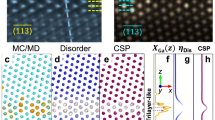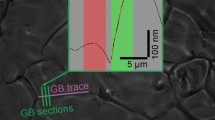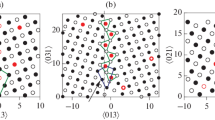Abstract
We examined the grain boundary energy (GBE) and grain boundary excess free volume (BFV) by applying the first-principles calculation for six [110] symmetric tilt grain boundaries in aluminum to clarify the origin of GBE. The GBE increased linearly as BFV increased. The elastic energy associated with BFV, namely the grain boundary elastic energy, was estimated as a function of BFV and the shear modulus. The grain boundary elastic energies were close in value to the GBEs. The charge density distributions indicated that the bonding in the grain boundary region is significantly different from the bonding in the bulk. The grain boundary elastic energies were 15–32% higher than the GBEs. This overestimation of the grain boundary elastic energy is caused by the characteristics of the electronic bonding at the grain boundary, which is different from bonding in the bulk. We have concluded that GBE results mainly from the grain boundary elastic energy.






Similar content being viewed by others
References
Merkle KL, Csencsits R, Rynes KL, Withrow JP, Stadelmann PA (1998) J Microsc 190:204
Shvindlerman LS, Gottstein G, Ivanov VA, Molodov DA, Kolesnikov D, Lojkowski W (2006) J Mater Sci 41:7725. doi:10.1007/s10853-006-0563-0
Shen TD, Zhang J, Zhao Y (2008) Acta Mater 56:3663
Wolf D (1989) Scr Metall 23:1913
Wolf D (1990) Acta Metall Mater 38:781
Huang YH, Zhang JM, Xu KW (2006) Appl Surf Sci 253:698
Takata N, Ikeda KI, Yoshida F, Nakashima H, Abe H (2004) J Jpn Inst Met 68:240
Rittner JD, Seidman DN (1996) Phys Rev B 54:6999
Chandra N, Dang P (1999) J Mater Sci 34:655. doi:10.1023/A:1004531706998
Rajgarhia RK, Saxena A, Spearot DE, Hartwig KT, More KL, Kenik EA, Meyer H (2010) J Mater Sci 45:6707. doi:10.1007/s10853-010-4764-1
Jiang Y, Smith JR (2009) J Mater Sci 44:1734. doi:10.1007/s10853-008-3084-1
Pilania G, Tan DQ, Cao Y, Venkataramani VS, Chen Q, Ramprasad R (2009) J Mater Sci 44:5249. doi:10.1007/s10853-009-3465-0
Wright AF, Atlas SR (1994) Phys Rev B 50:15248
Lu G, Kioussis N (2001) Phys Rev B 64:024101
Wang RZ, Kohyama M, Tanaka S, Tamura T, Ishibashi S (2009) Mater Trans 50:11
Inoue Y, Uesugi T, Takigawa Y, Higashi K (2007) Mater Sci Forum 561–565:1837
Uesugi T, Tsuchiya K, Kohyama M, Higashi K (2004) Mater Sci Forum 447–448:27
Ogata S, Kitagawa H, Maegawa Y, Saitoh K (1997) Comput Mater Sci 7:271
Fuchs M, Da Silva JLF, Stampfl C, Neugebauer J, Scheffler M (2002) Phys Rev B 65:245212
Segall MD, Lindan PJD, Probert MJ, Pickard CJ, Hasnip PJ, Clark SJ, Payne MC (2002) J Phys Condens Matter 14:2717
Hohenberg P, Kohn W (1964) Phys Rev 136:B864
Kohn W, Sham LJ (1965) Phys Rev 140:A1133
Perdew JP, Chevary JA, Vosko SH, Jackson KA, Pederson MR, Singh DJ, Fiolhais C (1992) Phys Rev B 46:6671
Vanderbilt D (1990) Phys Rev B 41:7892
Fischer TH, Almlof J (1992) J Phys Chem 96:9768
Monkhorst HJ, Pack JD (1976) Phys Rev B 13:5188
Chetty N, Weinert M, Rahman TS, Davenport JW (1995) Phys Rev B 52:6313
Uesugi T, Kohyama M, Higashi K (2003) Phys Rev B 68:184103
Hartford J, von Sydow B, Wahnstrom G, Lundqvist BI (1998) Phys Rev B 58:2487
Otsuki A, Mizuno M (1986) Trans Jpn Inst Met Suppl 27:789
Carling K, Wahnstrom G, Mattsson TR, Mattsson AE, Sandberg N, Grimvall G (2000) Phys Rev Lett 85:3862
Vitos L, Ruban AV, Skriver HL, Kollar J (1998) Surf Sci 411:186
Eshelby JD (1954) J Appl Phys 25:255
Friedel J (1954) Adv Phys 3:446
King HW (1966) J Mater Sci 1:79. doi:10.1007/BF00549722
Kittel C (1986) Introduction to solid state physics, 6th edn. Wiley, New York
Hirth JP, Lothe J (1982) Theory of dislocations, 2nd edn. Wiley, New York
Ehrhart P, Jung P, Schulta H, Ullmaier H (1990) In: Ullmaier H (ed) Atomic defects in metals, Landolt-Bornstein, new series, Group III, vol 25. Springer, Berlin, p 213
Feibelman PJ (1990) Phys Rev Lett 65:729
Acknowledgements
The authors are grateful to Mr. Yasuhiko Inoue and Mr. Yuuki Nishiie, who were students in the department, for their assistance with the computations. This study was partly supported by a Giant-in-Aid for scientific Research on the Priority Area “Giant Straining Process for Advanced Materials Containing Ultra-High Density Lattice Defects” from the Ministry of Education, Culture, Sports, Science and Technology (MEXT) and by the Light Metal Educational Foundation Inc. The authors thank Dr. Masanori Kohyama for useful discussion.
Author information
Authors and Affiliations
Corresponding author
Rights and permissions
About this article
Cite this article
Uesugi, T., Higashi, K. First-principles calculation of grain boundary energy and grain boundary excess free volume in aluminum: role of grain boundary elastic energy. J Mater Sci 46, 4199–4205 (2011). https://doi.org/10.1007/s10853-011-5305-2
Received:
Accepted:
Published:
Issue Date:
DOI: https://doi.org/10.1007/s10853-011-5305-2




